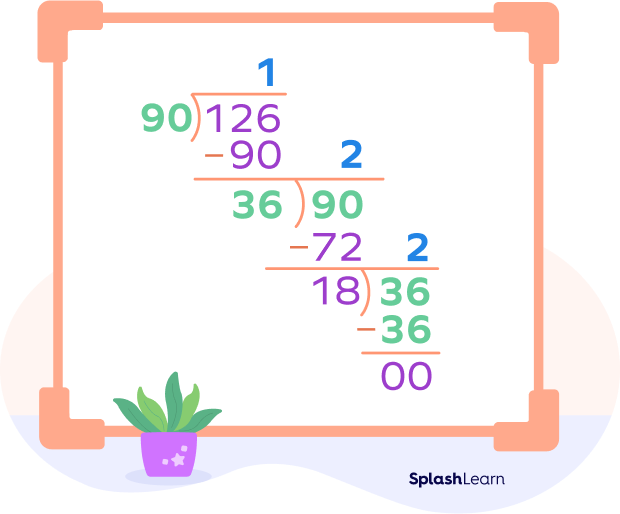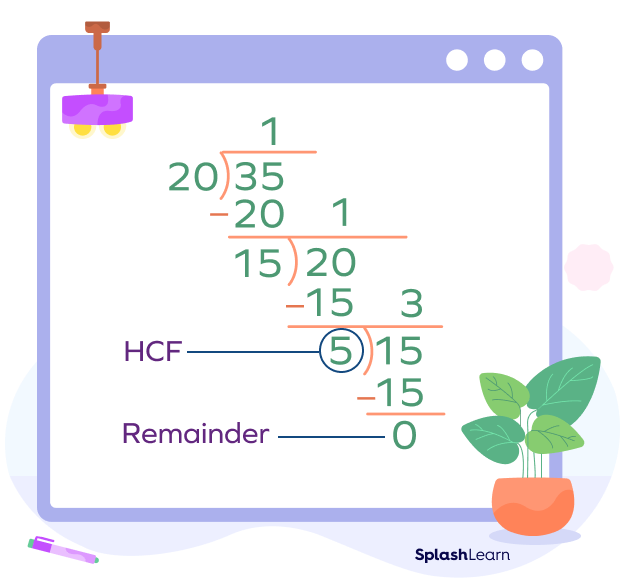What Is the Greatest Common Factor (GCF)?
The greatest common factor (GCF), also known as the greatest common divisor (GCD), is the largest positive integer that is a factor of two or more integers. In simple words, it is the largest number that divides the given set of integers evenly, without leaving any remainder.
Let’s quickly revise some important terms associated with the concept of GCF.
What is a Factor?
A factor is a number that divides another number evenly, leaving no remainder. In other words, if multiplying two whole numbers gives us a product, then the numbers we are multiplying are factors of the product. A number is always a factor of itself. 1 is a factor of all numbers.
Example: The factors 20 are 1, 2, 4, 5, 10 and 20.
What is a Common Factor?
As the name implies, a common factor of two or more numbers is a factor shared between the given set of numbers. In other words, it is a number that can evenly divide a set of two or more numbers.
Example: Find common factors of 24 and 30.
Factors of 24: 1, 2, 3, 4, 6, 8, 12, 24
Factors of 30: 1, 2, 3, 5, 6, 10, 15, 30
Common factors of 24 and 30: 1, 2, 3, 6
Recommended Games
Greatest Common Factor: Definition
The largest number, which is a factor of two or more numbers, is known as the Greatest Common Factor (GCF). It is the largest factor of the given set of numbers. The largest number identified in the list of common factors is known as the greatest common factor.
Other terms used to refer to GCF in math are GCD (Greatest Common Divisor) and HCF (Highest Common Factor).
Recommended Worksheets
How to Find the GCF
Following are the three methods to find the greatest common factor of two numbers:
- Listing out common factors
- Prime factorization
- Division method
Let’s discuss each method in detail.
- GCF by Listing Factors
In this method, we first list the factors of both the numbers, then it becomes easy to check for the common factors. By noting down the common factors, we can choose the greatest one amongst all of them.
Example: Find the GCF of 20 and 25.
Factors of 20: 1, 2, 4, 5, 10, and 20.
Factors of 25: 1, 5 and 25.
Common factors: 1 and 5.
Greatest Common Factor (GCF) = 5.
This method can be used for finding GCF of three or more numbers as well.
It might be difficult to find the greatest common factor by listing factors if the numbers are bigger. In such cases, we use the prime factorization method and division method for finding GCF.
- GCF by Prime Factorization Method
Prime factorization is a method of expressing a number as a product of its prime factors. Let’s understand how to find the GCF of two or more numbers using the prime factorization method.
Example: Find the GCF of 40 and 60.
Prime factorization of 40: 40 = 2 × 2 × 2 × 5
Prime factorization of 60: 60 = 2 × 2 × 3 × 5
Common factors of 40 and 60: 2, 2, 5
GCF is the product of the factors which are common to each of the given numbers.
GCF(40, 60) = 2 × 2 × 5 = 20
- GCF by Division Method
The long division method is a preferred method for finding the Greatest Common Factor (GCF) of large numbers. Follow these concise steps:
Step 1: Divide the larger number by the smaller one.
Step 2: Use the remainder as the new divisor and the previous divisor as the new dividend.
Step 3: Repeat the division with each new divisor and remainder until the remainder becomes 0.
Step 4: The last divisor that leaves no remainder is the GCD of the given numbers.
Example: Find the GCF of 90 and 126.

Hence, the GCF(90, 126) = 18
What Is the Difference between LCM and GCF?
| LCM vs. GCF | |
| Greatest Common Factor (GCF) | Least Common Multiple (LCM) |
| The largest number that divides all given numbers without leaving a remainder. | The smallest multiple that is divisible by all given numbers. |
| It is used to find the greatest shared factor among numbers. | It is used to find the smallest common multiple of numbers. |
| It is the greatest value in the intersection of the sets of common factors. | It is the minimum value in the intersection of the sets of common multiples. |
| Involves finding common prime factors and multiplying them together. | Involves finding the highest powers of common prime factors and multiplying them together. |
| Symbolic representation: GCF(a, b) or GCD(a, b) | Symbolic representation: LCM(a, b) |
Facts about Greatest Common Factor (GCF)
- If both numbers are prime, they have no common factors other than 1. Thus, the GCF of two prime numbers is 1.
- The GCF of 1 and any other positive integer is always 1.
- The product of the GCF and LCM of two numbers is equal to the product of the two numbers themselves.
- The GCF of any positive integer and 0 is the positive integer itself.
Conclusion
In this article, we learned about the Greatest Common Factor (GCF), the largest number that is a common factor of a given set of numbers. To reinforce our knowledge, let’s dive into solved examples on GCF and engage in MCQ practice.
Solved Examples on Greatest Common Factor (GCF)
1. Find the GCF of 10 and 15 by the listing method
Solution:
Factors of 10: 1, 2, 5, 10
Factors of 15: 1, 3, 5, 15
Common factors: 1, 5
Greatest common factor: 5
GCF(10, 15) = 5
2. Find the GCF of 42 and 56 using the prime factorization method.
Solution:
Prime factorization of 42: 42 = 2 × 3 × 7
Prime factorization of 56: 56 = 2 × 2 × 2 × 7
Common prime factors: 2, 7
GCF = 2 × 7 = 14
GCF(42, 56) = 14
3. Find the GCF of 16, 20 and 36.
Solution:
16 = 2 × 2 × 2 × 2
20 = 2 × 2 × 5
36 = 2 × 2 × 3 × 3
Common factors = 2, 2
GCF(16, 20, 36) = 2 × 2 = 4
4. What is the GCF of 45 and 75 using the prime factorization method?
Solution:
45 = 3 × 3 × 5
75 = 3 × 5 × 5
GCF(45, 75) = 3 × 5 = 15
5. Find the GCF of 20 and 35 using the long division method.
Solution:
First, we divide 35 by 20.
Quotient = 1, Remainder = 15
Next, we use the remainder (15) as the new divisor and the previous divisor (20) as the new dividend.
Quotient = 1, Remainder = 5
Repeat the same process.
New divisor = 5, new dividend = 15
Quotient = 3, Remainder = 0
Last divisor = 5
Hence, the GCF of 20 and 35 = 5

Practice Problems on Greatest Common Factor (GCF)
Greatest Common Factor (GCF)
Two wires measuring 14 inches and 18 inches are to be cut into smaller equal pieces. What would be the maximum possible length of each piece?
Length of 1st wire = 14 inches
Length of 2nd wire = 18 inches
Maximum length of each piece = GCF(14, 18)
14 = 2 × 7
18 = 2 × 3 × 3
GCF(14, 18) = 2
Maximum length of each pie = 2 inches
If the GCF of two numbers is 5 and their LCM is 60, what is the product of two numbers?
GCF = 5
LCM = 60
Product of numbers = LCM × HCF = 60 × 5 = 300
What is the GCF of 126 and 162?
126 = 2 ✕ 3 ✕ 3 ✕ 7
162 = 2 ✕ 3 ✕ 3 ✕ 3 ✕ 3
GCF(126, 162) = 2 ✕ 3 ✕ 3 = 18
What is the HCF of any two consecutive positive integers?
The HCF of any two consecutive positive integers is 1.
Frequently Asked Questions about Greatest Common Factor (GCF)
What is the relation between GCF and LCM of two numbers?
LCM of two numbers × GCF of two numbers = Product of two numbers
What is the GCF of two prime numbers?
The GCF of two prime numbers is always 1 because prime numbers have no common factors other than 1.
Can a GCF of two numbers be 0 or negative?
GCF of two numbers can never be 0 or negative.
Can the GCF be larger than the smallest number in a set?
No, the GCF cannot be larger than the smallest number in a set because it is, by definition, a factor of all the numbers involved.
What is the meaning of greatest common factor?
The Greatest Common Factor (GCF) is the largest positive integer that evenly divides two or more numbers without leaving a remainder. It represents the highest shared factor among those numbers.
How do you find the greatest common factor of two numbers?
To find the Greatest Common Factor (GCF) of two numbers, you can:
- List the prime factors of each number.
- Identify the common prime factors and multiply them together
What is the GCF of any positive integer and 0?
The Greatest Common Factor (GCF) of any positive integer and 0 is the positive integer itself. This is because any positive integer is always a factor of 0.
GCF(a, 0) = a, where “a” is any positive integer.




































